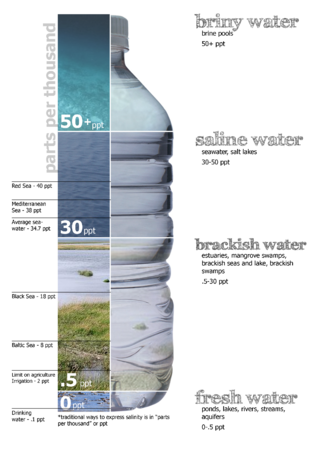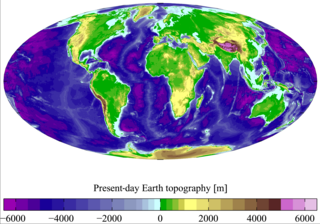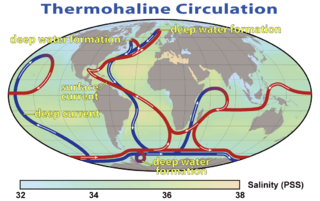This article relies largely or entirely on a single source .(November 2010) |
Paleosalinity (or palaeosalinity) is the salinity of the global ocean or of an ocean basin at a point in geological history.
This article relies largely or entirely on a single source .(November 2010) |
Paleosalinity (or palaeosalinity) is the salinity of the global ocean or of an ocean basin at a point in geological history.
From Bjerrum plots, it is found that a decrease in the salinity of an aqueous fluid will act to increase the value of the carbon dioxide-carbonate system equilibrium constants, (pK*). This means that the relative proportion of carbonate with respect to carbon dioxide is higher in more saline fluids, e.g. seawater, than in fresher waters. Of crucial importance for paleoclimatology is the observation that an increase in salinity will thus reduce the solubility of carbon dioxide in the oceans. Since there is thought to have been a 120 m depression in sea level at the last glacial maximum due to the extensive formation of ice sheets (which are solely freshwater), this represents a significant fractionation towards saltier seas during glacial periods. Correspondingly, this will cause a net outgassing of carbon dioxide into the atmosphere because of its reduced solubility, acting to increase atmospheric carbon dioxide by 6.5‰. This is thought to partly offset the net decrease of 80-100‰ observed during glacial periods. [1]
In addition, it is thought that extensive salinity stratification can lead to a reduction in the meridional overturning circulation (MOC) through the slowing of thermohaline circulation. Increased stratification means that there is effectively a barrier to subduction of parcels of water; isopycnals effectively do not outcrop at the surface and are parallel to the surface. The ocean, in this case, can be described as "less ventilated", and this has been implicated in the slowing down of the MOC.
There may exist proxies for salinity, but to date the main way that salinity has been measured has been by directly measuring chlorinity in pore fluids. [2] Adkins et al. (2002) used pore fluid chlorinity in ODP cores, with the paleo-depth estimated from nearby coral horizons. Chlorinity was measured rather than pure salinity because the major ions in seawater are not constant with depth in the sediment column; for example, sulfate reduction and cation-clay interactions can change overall salinity, whereas chlorinity is not heavily affected.
Adkins' study found that global salinity increased with a global sea level drop of 120 m. Analyzing 18O data they also found that deep waters were within error of the freezing point, with oceanic waters exhibiting a greater degree of homogeneity in temperatures. In contrast, variations in salinity were much greater than they are today. Modern day salinities are all within 0.5 psu of the global average salinity of 34.7 psu, whereas salinities during the last glacial maximum (LGM) ranged from 35.8 psu in the North Atlantic to 37.1 in the Southern Ocean.
There are some notable differences in the hydrography at the LGM and present day. Today the North Atlantic Deep Water (NADW) is observed to be more saline than Antarctic Bottom Water (AABW), whereas at the last glacial maximum it was observed that the AABW was in fact more saline; a complete reversal. Today the NADW is more salty because of the Gulf Stream; this could thus indicate a reduction of flow through the Florida Straits due to lowered sea level.
Another observation is that the Southern Ocean was vastly more salty at the LGM than today. This is particularly intriguing given the assumed importance of the Southern Ocean in oceanic dynamical regulation of ice ages. The extreme value of 37.1 psu is assumed to be a consequence of an increased degree of sea ice formation and export. This would account for the increased salinity, but would also account for the lack of oxygen isotopic fractionation; brine rejection without oxygen isotopic fractionation is thought to be highly characteristic of sea ice formation.
The presence of waters near the freezing point alters the balance of the relative effects of contrasts in salinity and temperature on sea water density. This is described in the equation,
where is the thermal expansion coefficient and is the haline contraction coefficient. In particular, the ratio is crucial. Using the observed temperatures and salinities, in the modern ocean, is about 10 whilst at the LGM it is estimated to have been closer to 25. The modern thermohaline circulation is thus more controlled by density contrasts due to thermal differences, whereas during the LGM the oceans were more than twice as sensitive to differences in salinity rather than temperature. In this way, the thermohaline circulation can be considered to have been less "thermo" and more "haline".
In a chemical reaction, chemical equilibrium is the state in which both the reactants and products are present in concentrations which have no further tendency to change with time, so that there is no observable change in the properties of the system. This state results when the forward reaction proceeds at the same rate as the reverse reaction. The reaction rates of the forward and backward reactions are generally not zero, but they are equal. Thus, there are no net changes in the concentrations of the reactants and products. Such a state is known as dynamic equilibrium.

Combustion, or burning, is a high-temperature exothermic redox chemical reaction between a fuel and an oxidant, usually atmospheric oxygen, that produces oxidized, often gaseous products, in a mixture termed as smoke. Combustion does not always result in fire, because a flame is only visible when substances undergoing combustion vaporize, but when it does, a flame is a characteristic indicator of the reaction. While activation energy must be supplied to initiate combustion, the heat from a flame may provide enough energy to make the reaction self-sustaining. The study of combustion is known as combustion science.

North Atlantic Deep Water (NADW) is a deep water mass formed in the North Atlantic Ocean. Thermohaline circulation of the world's oceans involves the flow of warm surface waters from the southern hemisphere into the North Atlantic. Water flowing northward becomes modified through evaporation and mixing with other water masses, leading to increased salinity. When this water reaches the North Atlantic, it cools and sinks through convection, due to its decreased temperature and increased salinity resulting in increased density. NADW is the outflow of this thick deep layer, which can be detected by its high salinity, high oxygen content, nutrient minima, high 14C/12C, and chlorofluorocarbons (CFCs).

Salinity is the saltiness or amount of salt dissolved in a body of water, called saline water. It is usually measured in g/L or g/kg.

Convection is single or multiphase fluid flow that occurs spontaneously through the combined effects of material property heterogeneity and body forces on a fluid, most commonly density and gravity. When the cause of the convection is unspecified, convection due to the effects of thermal expansion and buoyancy can be assumed. Convection may also take place in soft solids or mixtures where particles can flow.

In elementary algebra, the quadratic formula is a closed-form expression describing the solutions of a quadratic equation. Other ways of solving quadratic equations, such as completing the square, yield the same solutions.

Physical oceanography is the study of physical conditions and physical processes within the ocean, especially the motions and physical properties of ocean waters.

Thermohaline circulation (THC) is a part of the large-scale ocean circulation that is driven by global density gradients created by surface heat and freshwater fluxes. The adjective thermohaline derives from thermo- referring to temperature and -haline referring to salt content, factors which together determine the density of sea water. Wind-driven surface currents travel polewards from the equatorial Atlantic Ocean, cooling en route, and eventually sinking at high latitudes. This dense water then flows into the ocean basins. While the bulk of it upwells in the Southern Ocean, the oldest waters upwell in the North Pacific. Extensive mixing therefore takes place between the ocean basins, reducing differences between them and making the Earth's oceans a global system. The water in these circuits transport both energy and mass around the globe. As such, the state of the circulation has a large impact on the climate of the Earth.
The Lotka–Volterra equations, also known as the Lotka–Volterra predator–prey model, are a pair of first-order nonlinear differential equations, frequently used to describe the dynamics of biological systems in which two species interact, one as a predator and the other as prey. The populations change through time according to the pair of equations:
The environmental isotopes are a subset of isotopes, both stable and radioactive, which are the object of isotope geochemistry. They are primarily used as tracers to see how things move around within the ocean-atmosphere system, within terrestrial biomes, within the Earth's surface, and between these broad domains.
Spice, spiciness, or spicity, symbol τ, is a term in oceanography referring to variations in the temperature and salinity of seawater over space or time, whose combined effects leave the water's density unchanged. For a given spice, any change in temperature is offset by a change in salinity to maintain unchanged density. An increase in temperature decreases density, but an increase in salinity increases density. Such density-compensated thermohaline variability is ubiquitous in the upper ocean. Warmer, saltier water is more spicy while cooler, less salty water is more minty. For a density ratio of 1, all the thermohaline variability is spice, and there are no density fluctuations.

Double diffusive convection is a fluid dynamics phenomenon that describes a form of convection driven by two different density gradients, which have different rates of diffusion.
In mathematics and mechanics, the Euler–Rodrigues formula describes the rotation of a vector in three dimensions. It is based on Rodrigues' rotation formula, but uses a different parametrization.
Brine rejection is a process that occurs when salty water freezes. The salts do not fit in the crystal structure of water ice, so the salt is expelled.
Conservative temperature is a thermodynamic property of seawater. It is derived from the potential enthalpy and is recommended under the TEOS-10 standard as a replacement for potential temperature as it more accurately represents the heat content in the ocean.
The density ratio of a column of seawater is a measure of the relative contributions of temperature and salinity in determining the density gradient. At a density ratio of 1, temperature and salinity are said to be compensated: their density signatures cancel, leaving a density gradient of zero. The formula for the density ratio, , is:

The Turner angleTu, introduced by Ruddick(1983) and named after J. Stewart Turner, is a parameter used to describe the local stability of an inviscid water column as it undergoes double-diffusive convection. The temperature and salinity attributes, which generally determine the water density, both respond to the water vertical structure. By putting these two variables in orthogonal coordinates, the angle with the axis can indicate the importance of the two in stability. Turner angle is defined as:
The Atlantic meridional overturning circulation (AMOC) is a large system of ocean currents, like a conveyor belt. It is driven by differences in temperature and salt content and it is an important component of the climate system. However, the AMOC is not a static feature of global circulation. It is sensitive to changes in temperature, salinity and atmospheric forcings. Climate reconstructions from δ18O proxies from Greenland reveal an abrupt transition in global temperature about every 1470 years. These changes may be due to changes in ocean circulation, which suggests that there are two equilibria possible in the AMOC. Stommel made a two-box model in 1961 which showed two different states of the AMOC are possible on a single hemisphere. Stommel’s result with an ocean box model has initiated studies using three dimensional ocean circulation models, confirming the existence of multiple equilibria in the AMOC.
The Haline contraction coefficient, abbreviated as β, is a coefficient that describes the change in ocean density due to a salinity change, while the potential temperature and the pressure are kept constant. It is a parameter in the Equation Of State (EOS) of the ocean. β is also described as the saline contraction coefficient and is measured in [kg]/[g] in the EOS that describes the ocean. An example is TEOS-10. This is the thermodynamic equation of state.
Thermohaline staircases are patterns that form in oceans and other bodies of salt water, characterised by step-like structures observed in vertical temperature and salinity profiles; the patterns are formed and maintained by double diffusion of heat and salt. The ocean phenomenon consists of well-mixed layers of ocean water stacked on top of each other. The well-mixed layers are separated by high-gradient interfaces, which can be several meters thick. The total thickness of staircases ranges typically from tens to hundreds of meters.